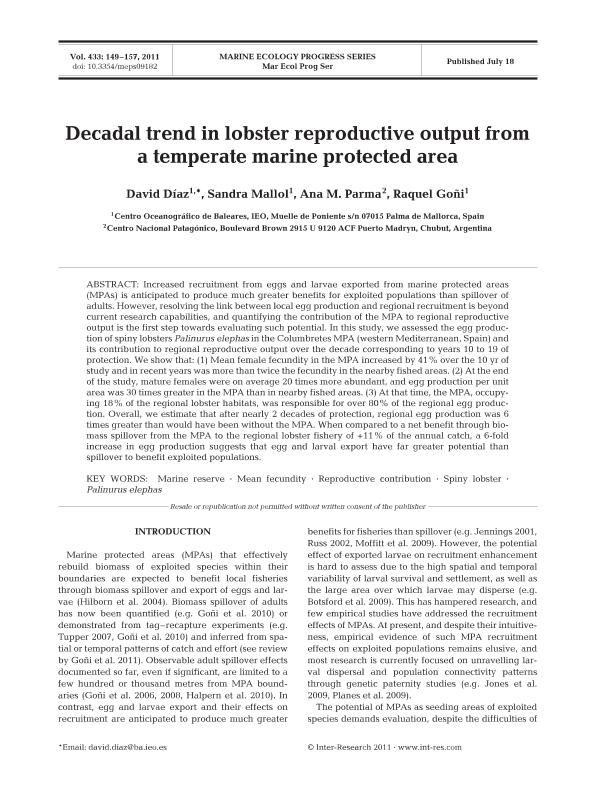Mostrar el registro sencillo del ítem
dc.contributor.author
Díaz, David
dc.contributor.author
Mallol, Sandra
dc.contributor.author
Parma, Ana María

dc.contributor.author
Goñi, Raquel
dc.date.available
2019-09-16T19:07:31Z
dc.date.issued
2011-07
dc.identifier.citation
Díaz, David; Mallol, Sandra; Parma, Ana María; Goñi, Raquel; Decadal trend in lobster reproductive output from a temperate marine protected area; Inter-Research; Marine Ecology Progress Series; 433; 7-2011; 149-157
dc.identifier.issn
0171-8630
dc.identifier.uri
http://hdl.handle.net/11336/83626
dc.description.abstract
Increased recruitment from eggs and larvae exported from marine protected areas (MPAs) is anticipated to produce much greater benefits for exploited populations than spillover of adults. However, resolving the link between local egg production and regional recruitment is beyond current research capabilities, and quantifying the contribution of the MPA to regional reproductive output is the first step towards evaluating such potential. In this study, we assessed the egg production of spiny lobsters Palinurus elephas in the Columbretes MPA (western Mediterranean, Spain) and its contribution to regional reproductive output over the decade corresponding to years 10 to 19 of protection. We show that: (1) Mean female fecundity in the MPA increased by 41% over the 10 yr of study and in recent years was more than twice the fecundity in the nearby fished areas. (2) At the end of the study, mature females were on average 20 times more abundant, and egg production per unit area was 30 times greater in the MPA than in nearby fished areas. (3) At that time, the MPA, occupying 18% of the regional lobster habitats, was responsible for over 80% of the regional egg production. Overall, we estimate that after nearly 2 decades of protection, regional egg production was 6 times greater than would have been without the MPA. When compared to a net benefit through biomass spillover from the MPA to the regional lobster fishery of +11% of the annual catch, a 6-fold increase in egg production suggests that egg and larval export have far greater potential than spillover to benefit exploited populations.
dc.format
application/pdf
dc.language.iso
eng
dc.publisher
Inter-Research

dc.rights
info:eu-repo/semantics/openAccess
dc.rights.uri
https://creativecommons.org/licenses/by-nc-sa/2.5/ar/
dc.subject
Marine Reserve
dc.subject
Mean Fecundity
dc.subject
Reproductive Contribution
dc.subject
Spiny Lobster
dc.subject
Palinurus Elephas
dc.subject.classification
Conservación de la Biodiversidad

dc.subject.classification
Ciencias Biológicas

dc.subject.classification
CIENCIAS NATURALES Y EXACTAS

dc.title
Decadal trend in lobster reproductive output from a temperate marine protected area
dc.type
info:eu-repo/semantics/article
dc.type
info:ar-repo/semantics/artículo
dc.type
info:eu-repo/semantics/publishedVersion
dc.date.updated
2019-08-23T18:38:17Z
dc.identifier.eissn
1616-1599
dc.journal.volume
433
dc.journal.pagination
149-157
dc.journal.pais
Alemania

dc.journal.ciudad
Oldendorf/Luhe
dc.description.fil
Fil: Díaz, David. Centro Oceanográfico de Baleares; España
dc.description.fil
Fil: Mallol, Sandra. Centro Oceanográfico de Baleares; España
dc.description.fil
Fil: Parma, Ana María. Consejo Nacional de Investigaciones Científicas y Técnicas. Centro Científico Tecnológico Conicet - Centro Nacional Patagónico; Argentina
dc.description.fil
Fil: Goñi, Raquel. Centro Oceanográfico de Baleares; España
dc.journal.title
Marine Ecology Progress Series

dc.relation.alternativeid
info:eu-repo/semantics/altIdentifier/doi/http://dx.doi.org/10.3354/meps09182
dc.relation.alternativeid
info:eu-repo/semantics/altIdentifier/url/https://www.int-res.com/abstracts/meps/v433/p149-157/
Archivos asociados
